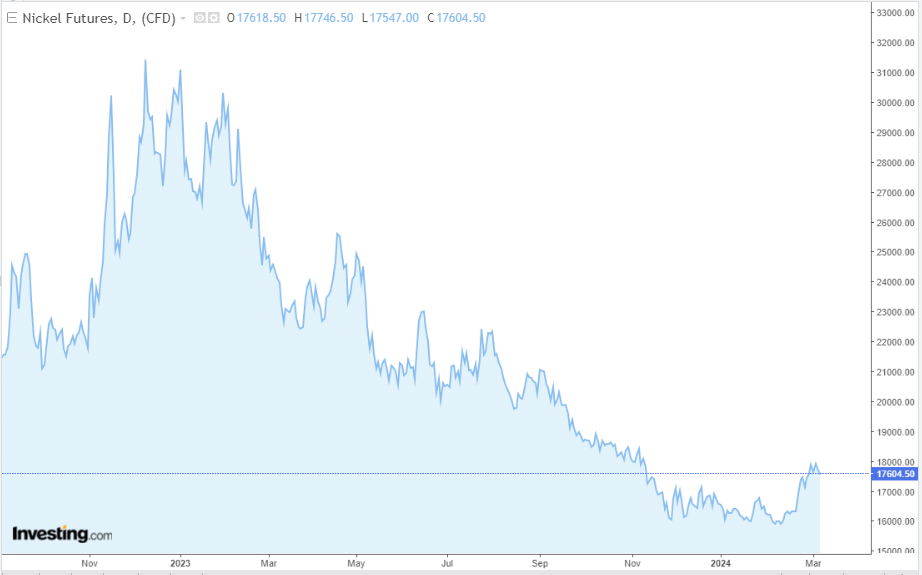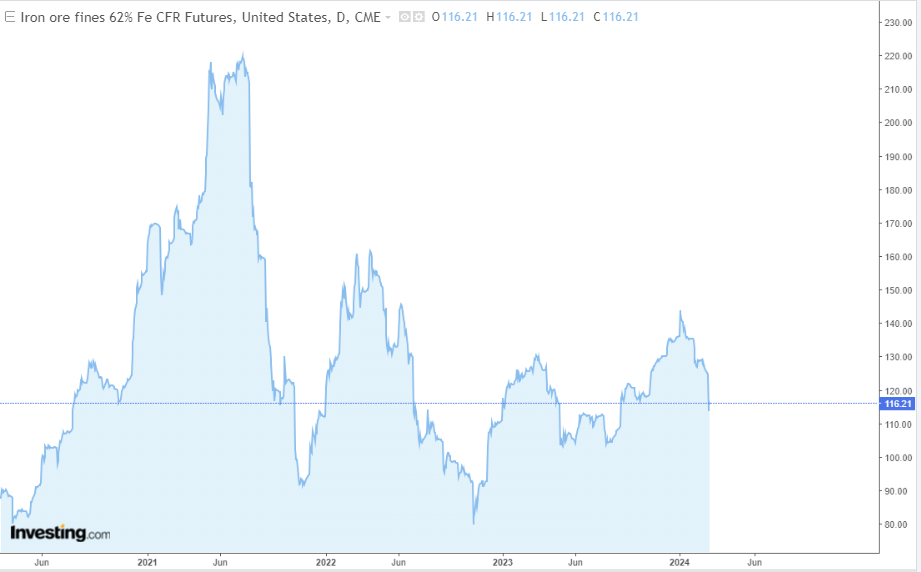- Nickel quotes rebounded after a prolonged decline in 2023, but the downtrend is set to continue.
- This comes after the Australian mining industry closed down more mines.
- Meanwhile, Iron ore fell to yearly lows. In this article, we will delve deep into why this price decline is likely to continue.
- In 2024, invest like the big funds from the comfort of your home with our AI-powered ProPicks stock selection tool. Learn more here>>
Iron ore and nickel have stood out in terms of volatility since the beginning of the current year.
Iron ore supply has faced headwinds due to oversupply at Chinese ports, leading to global supply pressures.
Meanwhile, nickel, with a rebound of slightly over 7%, broke its broad downward trend seen throughout 2023.
Political factors, like sanctions on Russia and its mining industry, have played a role in the price declines alongside demand and supply factors.
In this piece, we will try and analyze if the nickel prices have regained an uptrend, or if the current rebound is just a correction before prices resume lower again.
In Iron Ore's case, we will take a look at whether the prices will continue to decline despite the possibility of a supply surplus.
Have Nickel Prices Bottomed?
The downward trend in nickel prices since January 2023 is attributed to overestimations of the electric car industry's absorption capacity, resulting in increased inventories.
Indonesia's increased production, driven by Chinese investments, has contributed to the supply side. Simultaneously, Australia, the top nickel producer, has faced challenges, leading to mine closures and a bleak price outlook.
However, despite recent price rebounds driven by Western sanctions on Russia and diminishing inventories, the global market may still have a supply surplus.
A proper price uptrend would require a significant Chinese economic recovery and increased demand from the automotive industry. The recent uptick is more of a correction than a trend change.

Iron Ore Already Down 18%+ YTD
The price of iron ore has dropped by more than 18% since January, marking the largest decrease among major industrial commodities.
To understand this downward trend, we should focus on China. Recent data from China shows that crude inventories at its ports have consistently increased by 2.1%, reaching 133.1 million tons, the highest level since April of last year.
Additionally, favorable weather conditions in Australia have reduced the threat to port operations in Western Australia, benefiting iron ore producers.
Looking at the broader picture, it's important to note plans for one of the largest iron ore mining projects in recent decades, set to begin in Guinea.
This project, involving seven global companies led by Rio Tinto (NYSE:RIO), is expected to surpass $20 billion in total investment, covering the mine, rail, and port infrastructure.
Currently, there's a high likelihood of the price decrease continuing, with the next target being around $100, where the lowest prices were observed last August. 
***
Take your investing game to the next level in 2024 with ProPicks
Institutions and billionaire investors worldwide are already well ahead of the game when it comes to AI-powered investing, extensively using, customizing, and developing it to bulk up their returns and minimize losses.
Now, InvestingPro users can do just the same from the comfort of their own homes with our new flagship AI-powered stock-picking tool: ProPicks.
With our six strategies, including the flagship "Tech Titans," which outperformed the market by a lofty 1,183% over the last decade, investors have the best selection of stocks in the market at the tip of their fingers every month.
Subscribe here and never miss a bull market again!
Now with CODE INVESTINGPro1 you can get as much as a 10% discount on InvestingPro annual and two-year subscriptions.
Disclaimer: This article is written for informational purposes only; it does not constitute a solicitation, offer, advice, or recommendation to invest as such it is not intended to incentivize the purchase of assets in any way. I would like to remind you that any type of asset, is evaluated from multiple points of view and is highly risky and therefore, any investment decision and the associated risk remains with the investor.

